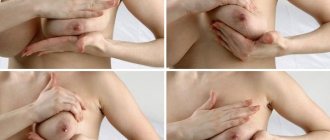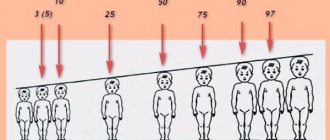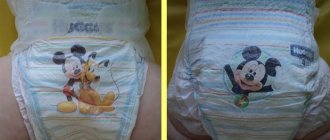Inflammation of the mammary gland, which most often develops in women during lactation, is called mastitis. However, the disease can occur not only in nursing mothers, but also in men, as well as in children under one year of age.
Neonatal mastitis is an acute infectious and inflammatory disease of the mammary glands in a child of the first year of life. Mastitis in children manifests itself as engorgement, swelling and redness of the skin over the affected area, as well as a local increase in temperature. Treatment of the disease can be either conservative or surgical.
How does physiological mastopathy differ from mastitis in newborns?
What happens to the baby's mammary glands after birth? The endocrine system is activated, so the baby’s body needs maternal hormones less and less. The pituitary gland of a small organism begins to produce estrogens, resulting in the release of prolactin: this causes engorgement of the mammary glands in the child, from which a milky fluid can be released.
Within a week after birth, the baby experiences a condition called a hormonal crisis. Nature is designed in such a way that it is the hormonal crisis that forces the body to adapt to the world: having gone through it, the child receives certain protection from problems with the immune and neurological system.
Sexual crisis - what is it?
Symptoms of a gentle crisis in recently born children are manifested not only by swelling of the glands located on the chest, there may even be swelling of the external genital organs, milia (white spots) on the face, fluid leakage from the genital tract (girls have both white and bloody discharge ). Sexual crisis occurs in 75% of newborns, including boys.
Basically, symptoms of a sexual crisis accompany absolutely healthy children; doctors think that this is a sign of the child’s uncomplicated reaction to outdoor life. Premature and low birth weight newborns with sexual crisis are quite rare.
Swelling of the mammary glands is an individual physiological process.
Swelling of the mammary glands in newborns is called physiological mastopathy. It is noticed by a change in the size and density of the baby's breasts. Most often, engorgement of two mammary glands is noticed, and very rarely it appears on one side.
This does not cause any problems for the baby, so it is not recommended to take any specialized actions. Often, swelling of the mammary glands accompanies the baby from the first week of his life, and at the end of the first month of life the swelling goes away on its own.
It is important to know! The most normal enlargement of the mammary glands is up to 3 cm in diameter. And the epidermis should not have any changes or redness... Treatment of breast engorgement:
Treatment of breast engorgement:
Most parents are trying to cope with any changes in their babies’ bodies. You should not treat breast engorgement on your own. Some parents begin to feel the bruised area in hopes of seeing if it will help reduce swollen breasts. But all you will achieve by doing this will be irritation of your baby’s mammary glands.
Since this is not a serious problem, give the baby some time. By the fifth week of life, your baby's breasts will begin to contract naturally.
Don't massage the swollen area too often. Excessive breast massage or pinching can lead to infection. Therefore, all you have to do is simply give your baby a bath.
It is not recommended to make any compresses or use ointments.
Breast-feeding.
Breastfeeding can contribute to the baby's breast swelling due to the continued transfer of hormones to the mother through milk. That is, breastfeeding may also promote long-term breast enlargement and milk production (witches milk) in the infant, but weaning is not recommended.
Why does newborn mastitis develop?
If, during the development of physiological mastopathy, an infection enters the child’s body (usually staphylococcal or streptococcal), there is a risk of newborn mastitis: moreover, it can occur in both newborn girls and newborn boys. Staphylococcal or streptococcal bacteria can live in the mother's body (for example, on the surface of her skin or on the mucous membrane of the nasopharynx), and can also be found on surfaces in toilets and bathrooms.
Most often, mastitis in a newborn develops after discharge from the hospital - approximately on the 10th day of the baby’s life. By this time, the baby’s mammary glands should return to normal. And if the mother sees that this did not happen, it is necessary to urgently consult a pediatrician.
Microorganisms enter the body under certain conditions, usually when parents do not properly care for the child, not taking into account the special properties of his skin:
- it has a lot of microvessels;
- it has high permeability, so any substances from its surface immediately enter the body and the bloodstream;
- the fatty tissue under the skin is very thick and loose;
- sweat and sebaceous glands cannot yet function normally and create antibacterial protection; and if maternal immunity was unable to protect the child from bacteria (after all, the baby’s skin does not immediately accept all its microorganisms from the mother - the process of this colonization occurs gradually), they immediately cause an infectious pathology in the body;
- the thermoregulation process has not yet been adjusted;
- the skin is very saturated with liquid.
- How and why can an infection occur?
- if the child is dressed without taking into account the air temperature, and diaper rash occurs on his skin;
- if, while treating the child’s skin, the mother accidentally scratches or damages the skin (for example, with a manicure).
if the baby’s clothes have rough seams or edges that injure delicate skin;
When should you see a doctor?
As described earlier, there is no reason to panic, as everything will go away naturally in 5-8 weeks.
But there are some factors, when they appear, you need to consult a doctor. Sometimes swollen breasts (in boys and girls) become red or swollen too much. In such cases, you should consult your pediatrician immediately. If your baby has a high fever along with swollen breasts for a long time, then you need to consult a doctor immediately.
If the swelling is getting bigger every day rather than getting smaller, then you definitely need to worry.
As a parent, you worry about your child, especially if there are any changes in his body, but there are certain changes that are normal. So, if your newborn baby does not have the factors described above, then there is no reason to worry and soon the engorgement will go away on its own.
Signs of mastitis in newborns
- when touching the mammary glands, the baby cries;
- as a rule, the infection penetrates into one of the glands (much less often it affects both), due to which the mammary gland becomes denser, the baby develops severe pain when touched;
- in the area of infection the skin turns red;
- The baby’s body temperature rises to 39 °C;
- the child cries when he is swaddled or changed;
- the baby refuses to breastfeed and becomes lethargic;
- later, pus accumulates at the site of infection; when pressure is applied to this area, the child screams very loudly and experiences pain;
- with purulent mastitis, pus may spontaneously (without pressure) be released from the nipples of a newborn.
This condition is extremely dangerous for a child. Therefore, at the first symptoms of mastitis, you should consult a pediatrician or call an ambulance. If help is not provided in time, the pus can melt the tissues near the mammary gland and penetrate into its other parts. This condition can lead to a diagnosis of phlegmon of the chest wall - purulent inflammation of fatty tissue. More serious conditions that mastitis in a newborn can lead to are sepsis and generalized infection (spread of infection throughout the body), which threatens the life of the child.
For a newborn girl, mastitis is more dangerous than for a boy: if the acini (components of the mammary gland) die during the disease, connective tissue appears in their place. In this case, when the girl grows up, her breasts will most likely develop asymmetrically. And during breastfeeding, an adult woman runs the risk of serious lactostasis (milk stagnation), which will be difficult to cure without surgery.
A fine line between normality and pathology
Small cracks on the chest against the background of hormonal transformations in just 1 to 6 days can develop into full-fledged mastitis, requiring immediate treatment. This is why it is so important to treat babies with tenderness and care.
Mastitis is an inflammation of the breast tissue. Usually it threatens nursing mothers, but it is also dangerous for children at the time of physiological breast swelling. If after 6–8 days the baby’s well-being has not improved, the glands continue to enlarge, and the discharge becomes abundant, you should immediately consult a doctor.
We also recommend viewing: When the mammary glands begin to hurt severely during pregnancy
Severely hyperemic skin, general malaise, restlessness of the baby, increased temperature indicate inflammatory reactions. Such a pathological process will not disappear on its own.
How is mastitis treated in newborns?
Clinical guidelines for the treatment of neonatal mastitis state that before prescribing therapy, it is necessary to establish the stage of development of the disease.
If this is the initial (infiltrative) stage, then treatment of mastitis in a newborn is recommended:
- special ointments applied to the bandage;
- ultraviolet irradiation or UHF, which has a detrimental effect on bacteria;
- compresses with magnesium to relieve swelling and pain;
- compresses of dimexide with saline as an antiseptic;
- alcohol compresses;
- Vishnevsky ointment;
- suppositories or syrup with paracetamol to relieve pain and fever;
- Treatment of neonatal mastitis can be enhanced with broad-spectrum antibiotics.
However, all of the above actions can be effective until a purulent focus has formed in the gland. If it occurs, the newborn will most likely require surgery, during which the pus will be removed and the cavity will be washed. After surgery, a bandage with a hypertonic solution will be applied to the wound. In addition, the doctor will prescribe a course of antibiotics.
Treatment
The sexual crisis itself in children under one year of age does not need to be treated. The general procedure for adults follows normal daily procedures. The most important thing is maintaining hygiene: changing clothes in a timely manner, ironing all things before use. It is advisable to carry out bathing procedures in boiled water. For sterility, it is possible to add a little potassium permanganate.
All kinds of compresses and lotions are strictly prohibited - they can damage the skin, that is, cause infection. Never indulge the urge to squeeze discharge from swollen breasts, especially if there are purulent areas.
Having noticed that in addition to breast swelling, the disease is combined with an increase in temperature, parents should immediately consult a doctor (for more details, see the article: What temperature is considered normal in an infant?). All treatment procedures must be carried out in a hospital. The initial form of the disease involves the use of antibiotics and drugs aimed at relieving inflammation. Treatment also includes the application of ointments and medicinal solutions. All procedures are carried out strictly under the supervision of doctors.
An important preventive measure is bathing a newborn in boiled water.
When the disease has already entered the acute stage and there are signs of an abscess, immediate surgical intervention is required. Doctors open the festering area and wash out the pus. A severe course of the disease, which has progressed to phlegmon or sepsis, requires moving the child to the intensive care unit, which is associated with a severe deterioration in his health.
Mastitis in later adult life is not as dangerous for boys as it is for girls. Girls who have had mastitis in childhood often experience blockage of the milk ducts and inflammation of the breasts during puberty and during lactation (we recommend reading: how should you care for a newborn girl?). All this can lead to the impossibility of the breastfeeding process itself, and in addition, the risk of mastopathy and oncology sharply increases.
How to prevent mastitis in a newborn
- take care of your baby’s skin correctly, prepare the baby’s first clothes in advance: wash them with a special baby powder and be sure to iron them (this must also be done during the entire first month after discharge from the hospital);
- when, as a result of a hormonal crisis, the child’s mammary glands become engorged, do not touch or put pressure on them, and under no circumstances squeeze out their contents;
- dress the child in accordance with the temperature regime, do not overheat his body;
- On the eve of giving birth, get rid of long manicures and carefully treat your nails.
Treatment of breast inflammation
With physiological engorgement of the mammary glands, specific treatment is not required. The little patient must be provided with peace. There is no point in using folk remedies, applying ointments and creams during sexual crisis in newborns.
You can damage your baby's delicate skin, increasing the risk of infection. If the breasts are swollen, the famous pediatrician Komarovsky recommends avoiding tight swaddling, especially in the area of the mammary glands. He advises mothers not to be nervous, but to be patient and wait a little.
For diseases of the mammary glands, the treatment regimen is very different. If, based on the results of a visual examination and ultrasound, pathological mastitis or mastopathy is diagnosed, the baby is hospitalized. In most cases, the disease can be managed with conservative therapy; in emergency situations, the patient is referred for surgery.
The treatment of mastitis in girls must be approached with all responsibility, because even at this age, a long-term inflammatory process can lead to blockage of the ducts. In this case, the growth and function of the mammary gland will be impaired.
With natural breast enlargement, parents should ensure that the child’s personal hygiene is observed. It is necessary to regularly carry out water procedures, change clothes more often and avoid contact with dirty things.
In order to prevent complications, experts recommend that small patients apply a dry, clean cloth to the inflamed gland. This will prevent bacteria from entering the gland through the lymphatic ducts or causing damage to the skin.
If the swollen glands are enlarged, a ball is felt in the chest upon palpation, and conservative therapy does not give the desired results, the abscess is opened. The surgeon makes a small incision (1–1.5 cm) in the chest, and then the wound is drained.
Due to the fact that it is difficult to completely clean the wound of pathogenic microflora, the child must continue taking antibiotics. Often patients are sent for repeated operations to eliminate newly accumulated purulent exudate.
Mastitis in a child requires immediate medical attention. Do not under any circumstances try to treat an illness at home with folk remedies. At the initial stage, when there is no purulent content, conservative methods help - antibiotics and anti-inflammatory drugs are used.
In the purulent phase, surgical measures are required. The surgeon makes an incision in the areola under anesthesia, the purulent contents are removed, and antibiotic therapy is subsequently administered. Absorbable and antiseptic bandages are applied to the affected area. Vitamins and physiotherapy are prescribed as a supportive measure.
Diagnosis of the disease
Diagnosis of the disease is based on the characteristic symptoms of the disease and the deterioration of the baby’s well-being.
At the first signs of mastitis in a baby, parents should immediately contact a specialist. A qualified physician determines the presence of mastitis immediately by visual examination, noting:
- Increase in breast size.
- The chest feels hot to the touch.
- Feeling of fluctuation or unevenness of gland tissue due to purulent accumulation.
- Crying of a child when palpating the breast due to its soreness.
To identify the specific pathogenic causative agent of the disease, doctors insist on culture of nipple secretions. Simultaneously with bacterial culture, the sensitivity of the pathogenic organism to antibiotics is determined.
Regarding hardware examination methods, in most situations there is no need to use them if mastitis has a characteristic symptomatic picture, but in order to clarify the diagnosis, an ultrasound scan can be prescribed.
First of all, the differential diagnosis of mastitis is compared with the following diseases:
- Physiological type mastopathy.
- Erysipelas inflammation of the skin.
- A consultation with a surgeon may also be required.
Additional methods for diagnosing inflammatory pathology are not used, as they can be difficult for such small patients, so if the baby was absolutely healthy before mastitis, then the study is limited to generally accepted laboratory tests.
Head
Immediately after birth, the shape of the head can be deformed, because during natural childbirth it is compressed, and even the bones of the skull are displaced (“Caesarean babies,” by the way, usually have a perfectly straight head). Gradually it will take on a more or less rounded shape.
The head really looks very large - it is ¼ of the whole body. For newborns this is the absolute norm; gradually the body proportions will change. In full-term boys, the head circumference is on average 34.9 cm, in girls - 34 cm.
The eyes of all newborns are approximately the same color - an indeterminate gray-blue, because there is still little pigment in the iris. The final eye color will only be determined after 1-2 years.
Discharge
In 70% of newborns, urination occurs for the first time in the first 12 hours of life (sometimes this happens right during childbirth or immediately after it), in 10% - on the second or even third day. All these are variants of the norm. Usually, in the first days after birth, children pee little, because they mainly feed only on thick colostrum. But when the mother produces real, mature milk, the number of urinations reaches 20 times a day. At first, the urine may be dark yellow or even brown, but later it will become colorless.
The stool in the first two days is viscous, black or black-green. This is meconium. From the second to the fourth day, its appearance and consistency gradually changes. And from the fourth day it takes on its usual appearance - mushy, from straw to bright yellow. Its consistency is not always uniform, there may be curdled lumps, but mucus and foam should alert you - this means that there is some kind of malfunction in the digestive system.
Physiology of infants
Breast tissue is very sensitive to hormonal fluctuations. Breast development is primarily influenced by estrogen. The more female sex hormone enters the mammary gland tissue, the larger it grows. All children, regardless of gender, experience slight breast enlargement in the first days of life. It is associated with the release of hormones before childbirth. Over time, the swelling subsides.
As the child develops, the mammary glands become coarser
This process is called physiological mastopathy (it is important to distinguish it from pathology - mastopathy, which also occurs in infants). The baby grows and the breasts become larger and denser
Moreover, the process may occur unevenly: on one gland the swelling is visible, on the other – not. This condition does not require treatment and does not cause discomfort to the baby. Normally, swelling stops a month after birth.
Normal child development involves:
- Breast swelling up to a maximum of 3 cm.
- The appearance of slightly colored, often colorless, discharge.
- Swollen nipples.
- Rough nipples and halos.
It is important not to injure the breasts, select the softest clothes and diapers, and do not try to squeeze out the contents of the breast. Otherwise, you can cause an infection and cause the formation of microcracks around the nipple
Bacteria can penetrate through them, and the child will experience significant discomfort. It is necessary to adhere to the rules of hygiene and ensure that the baby does not injure the breast. If you have any concerns about your child’s condition, you should immediately consult a specialist.
If you notice discharge and swelling in the first month, do not worry - this is a physiological process that is not dangerous for the baby
However, it is important to distinguish natural swelling from disease. Fortunately, mastitis and tumors rarely affect infants, however, some breast diseases can also occur in children











